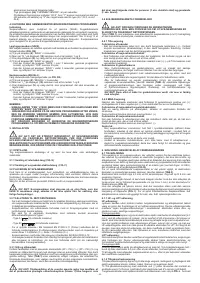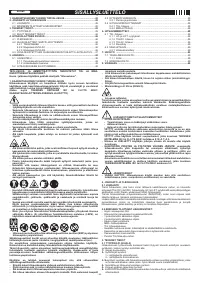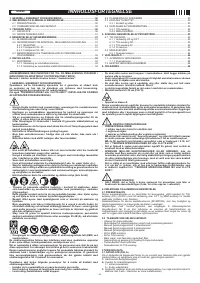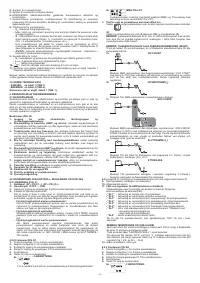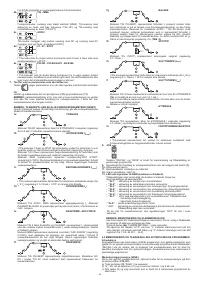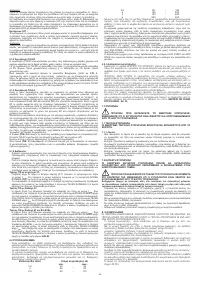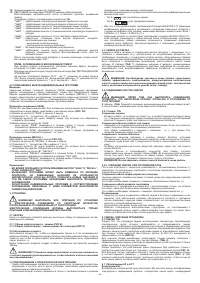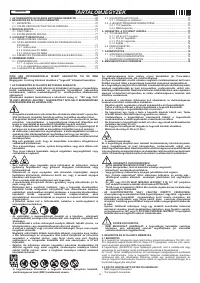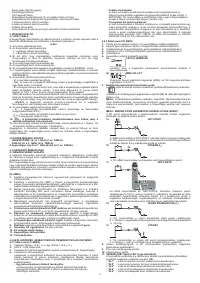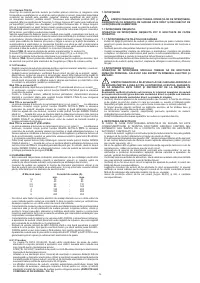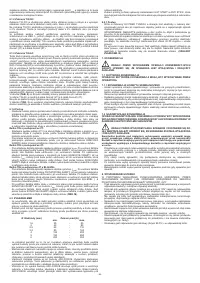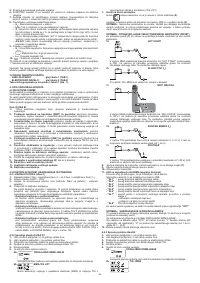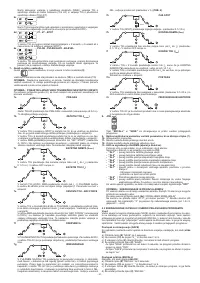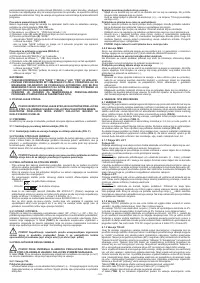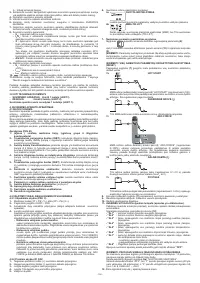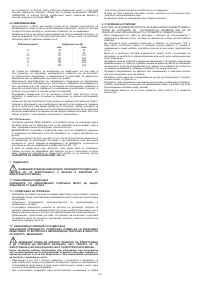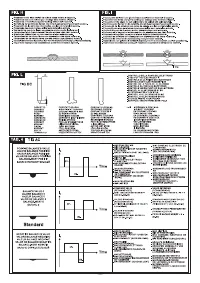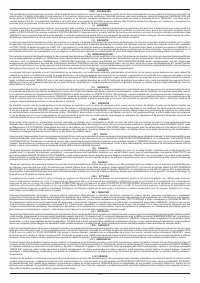Сварочное оборудование Telwin SUPERIOR TIG 422 AC DC HF LIFT - инструкция пользователя по применению, эксплуатации и установке на русском языке. Мы надеемся, она поможет вам решить возникшие у вас вопросы при эксплуатации техники.
Если остались вопросы, задайте их в комментариях после инструкции.
"Загружаем инструкцию", означает, что нужно подождать пока файл загрузится и можно будет его читать онлайн. Некоторые инструкции очень большие и время их появления зависит от вашей скорости интернета.
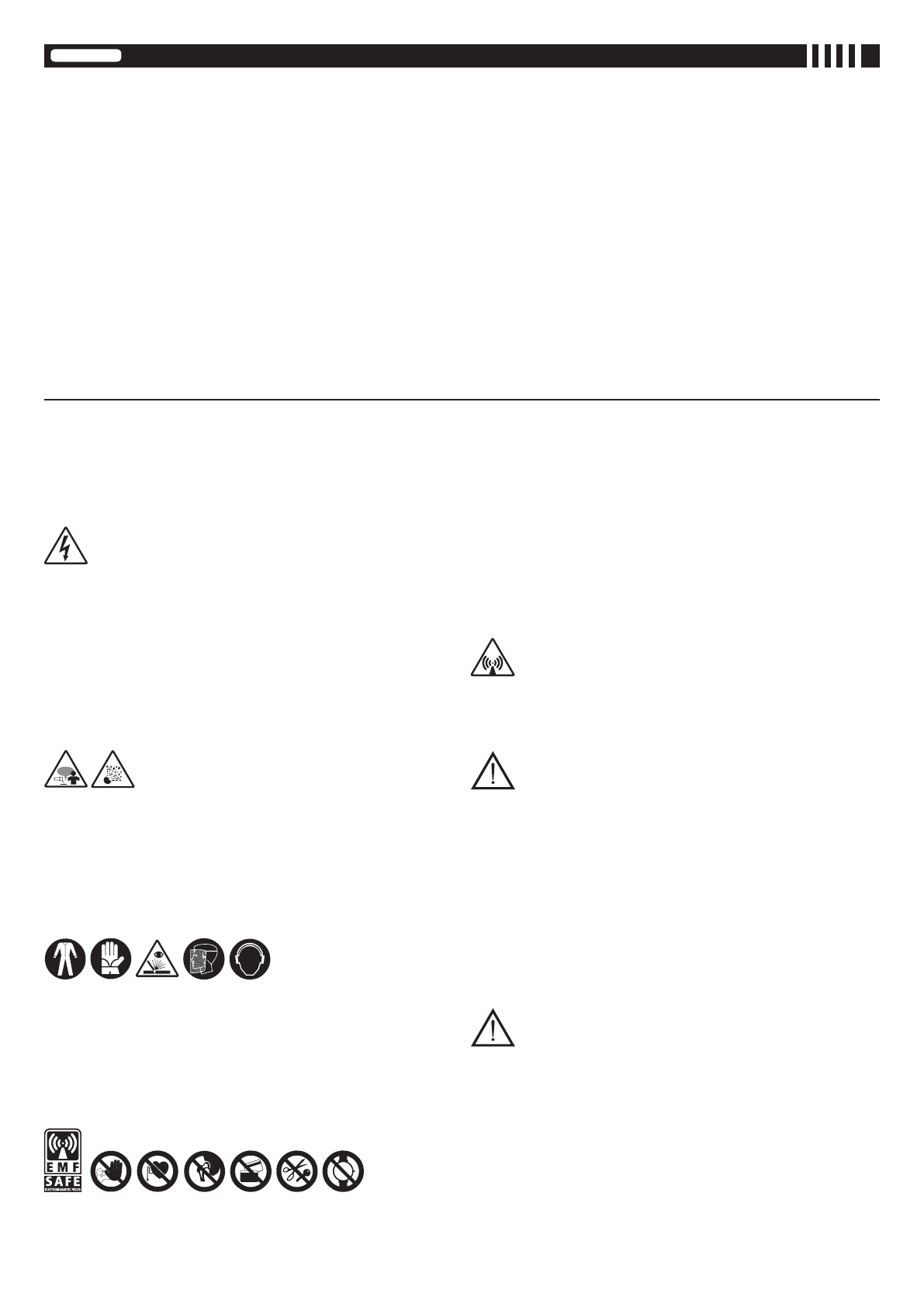
- 5 -
INVERTER WELDING MACHINES FOR TIG AND MMA WELDING DESIGNED FOR
INDUSTRIAL AND PROFESSIONAL USE.
Note: In the following text the term “welding machine” will be used.
1. GENERAL SAFETY CONSIDERATIONS FOR ARC WELDING
The operator should be properly trained to use the welding machine safely
and should be informed about the risks related to arc welding procedures, the
associated protection measures and emergency procedures.
(Refer also to the “IEC TECHNICAL SPECIFICATION or CLC/TS 62081”:
INSTALLATION AND USE OF EQUIPMENT FOR ARC WELDING).
- Avoid direct contact with the welding circuit: the no-load voltage supplied by
the welding machine can be dangerous under certain circumstances.
- When the welding cables are being connected or checks and repairs are
carried out the welding machine should be switched off and disconnected
from the power supply outlet.
- Switch off the welding machine and disconnect it from the power supply
outlet before replacing consumable torch parts.
- Make the electrical connections and installation according to the safety rules
and legislation in force.
- The welding machine should be connected only and exclusively to a power
source with the neutral lead connected to earth.
- Make sure that the power supply plug is correctly connected to the earth
protection outlet.
- Do not use the welding machine in damp or wet places and do not weld in the
rain.
- Do not use cables with worn insulation or loose connections.
- Do not weld on containers or piping that contains or has contained flammable
liquid or gaseous products.
- Do not operate on materials cleaned with chlorinated solvents or near such
substances.
- Do not weld on containers under pressure.
- Remove all flammable materials (e.g. wood, paper, rags etc.) from the working
area.
- Provide adequate ventilation or facilities for the removal of welding fumes near
the arc; a systematic approach is needed in evaluating the exposure limits for
the welding fumes, which will depend on their composition, concentration
and the length of exposure itself.
- Keep the gas bottle (if used) away from heat sources, including direct
sunlight.
- Use adequate electrical insulation with regard to the electrode, the work piece
and any (accessible) earthed metal parts in the vicinity.
This is normally achieved by wearing gloves, shoes, head coverings and
clothing designed for this purpose and by using insulating platforms or
mats.
- Always protect your eyes using masks or helmets with special actinic glass.
Use special fire-resistant protective clothing and do not allow the skin to be
exposed to the ultraviolet and infrared rays produced by the arc; other people
in the vicinity of the arc should be protected by shields of non-reflecting
curtains.
- Noise level: If particularly intensive welding operations cause a personal
daily exposure level (LEPd) that is greater than or equal to 85db(A), the use of
suitable personal protectors is compulsory.
- The flow of the welding current generates electromagnetic fields (EMF) around
the welding circuit.
Electromagnetic fields can interfere with certain medical equipment (e.g. Pace-
makers, respiratory equipment, metallic prostheses etc.).
Adequate protective measures must be adopted for persons with these types of
medical apparatus. For example, they must be forbidden access to the area in
which welding machines are in operation.
This welding machine conforms to technical product standards for exclusive
use in an industrial environment for professional purposes. It does not assure
compliance with the basic limits relative to human exposure to electromagnetic
fields in the domestic environment.
The operator must adopt the following procedures in order to reduce exposure
to electromagnetic fields:
- Fasten the two welding cables as close together as possible.
- Keep head and trunk as far away as possible from the welding circuit.
- Never wind welding cables around the body.
- Avoid welding with the body within the welding circuit. Keep both cables on
the same side of the body.
- Connect the welding current return cable to the piece being welded, as close
as possible to the welding joint.
- Do not weld while close to, sitting on or leaning against the welding machine
(keep at least 50 cm away from it).
- Do not leave objects in ferromagnetic material in proximity of the welding
circuit.
- Minimum distance d: 20 cm (Fig. O).
- Class A equipment:
This welding machine conforms to technical product standards for exclusive
use in an industrial environment and for professional purposes. It does not
assure compliance with electromagnetic compatibility in domestic dwellings
and in premises directly connected to a low-voltage power supply system
feeding buildings for domestic use.
EXTRA PRECAUTIONS
WELDING OPERATIONS:
- In environments with increased risk of electric shock.
- In confined spaces.
- In the presence of flammable or explosive materials.
MUST BE evaluated in advance by an “Expert supervisor” and must always
be carried out in the presence of other people trained to intervene in
emergencies.
Technical protection measures MUST BE taken as described in 5.10; A.7; A.9.
of the “IEC TECHNICAL SPECIFICATION or CLC/TS 62081”.
- The operator MUST NOT BE ALLOWED to weld in raised positions unless
safety platforms are used.
- VOLTAGE BETWEEN ELECTRODE HOLDERS OR TORCHES: working with
more than one welding machine on a single piece or on pieces that are
connected electrically may generate a dangerous accumulation of no-load
voltage between two different electrode holders or torches, the value of which
may reach double the allowed limit.
An expert coordinator must use measuring instruments to determine the
existence of a risk and should take suitable protection measures as detailed
in 5.9 of the “IEC TECHNICAL SPECIFICATION or CLC/TS 62081”.
RESIDUAL RISKS
- IMPROPER USE: it is hazardous to use the welding machine for any work
other than that for which it was designed (e.g. de-icing mains water pipes).
2. INTRODUCTION AND GENERAL DESCRIPTION
2.1 INTRODUCTION
This welding machine is a power source for arc welding, made specifically for TIG
(DC) (AC/DC) welding with HF or LIFT strike and MMA welding with coated electrodes
(rutile, acid, basic).
The particular features of this welding machine (INVERTER), such as high-speed and
precise adjustment, result in excellent quality welds.
The inverter system of regulation at the power supply input (primary) also leads to a
drastic decrease in the volume of both the transformer and the levelling reactance so
that it is possible to build a considerably smaller, lighter welding machine, highlighting
its advantages of easy handling and transport.
2.2 OPTIONAL ACCESSORIES
- Argon bottle adapter.
- Welding current return cable complete with earth clamp.
- Manual remote control with 1 potentiometer.
ENGLISH
INDEX
1. GENERAL SAFETY CONSIDERATIONS FOR ARC WELDING ...........................5
2. INTRODUCTION AND GENERAL DESCRIPTION ................................................5
2.1 INTRODUCTION .............................................................................................5
2.2 OPTIONAL ACCESSORIES ............................................................................5
3. TECHNICAL DATA .................................................................................................6
3.1 DATA PLATE ....................................................................................................6
3.2 OTHER TECHNICAL DATA .............................................................................6
4. DESCRIPTION OF THE WELDING MACHINE ......................................................6
4.1 BLOCK DIAGRAM ...........................................................................................6
4.2 CONTROL, ADJUSTMENT AND CONNECTION DEVICES ...........................6
4.2.1 BACK PANEL .........................................................................................6
4.2.2 FRONT PANEL (FIG. D1) ......................................................................6
4.2.3 FRONT PANEL (FIG. D2) ......................................................................7
4.3 STORING AND RECALLING OF PERSONALISED PROGRAMS ..................8
5. INSTALLATION ......................................................................................................8
5.1 PREPARATION ................................................................................................8
5.1.1 Assembling the return cable-clamp........................................................8
5.1.2 Assembling the welding cable-electrode holder clamp ..........................8
5.2 POSITION OF THE WELDING MACHINE ......................................................8
5.3 CONNECTION TO THE MAIN POWER SUPPLY ...........................................8
5.3.1 Plug and outlet .......................................................................................8
5.4 CONNECTION OF THE WELDING CABLES ..................................................8
5.4.1 TIG welding ............................................................................................8
5.4.2 MMA WELDING .....................................................................................8
6. WELDING: DESCRIPTION OF THE PROCEDURE ..............................................8
6.1 TIG WELDING .................................................................................................8
6.1.1 HF and LIFT strike .................................................................................8
6.1.2 TIG DC welding ......................................................................................8
6.1.3 TIG AC welding .....................................................................................9
6.1.4 Procedure ..............................................................................................9
6.2 MMA WELDING ...............................................................................................9
6.2.1 Procedure ..............................................................................................9
7. MAINTENANCE ......................................................................................................9
7.1 ROUTINE MAINTENANCE .............................................................................9
7.1.1 Torch ......................................................................................................9
7.2 EXTRAORDINARY MAINTENANCE ...............................................................9
8. TROUBLESHOOTING ............................................................................................9
page
page










































